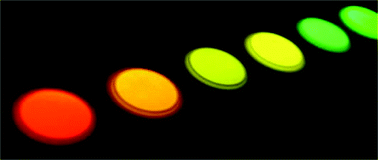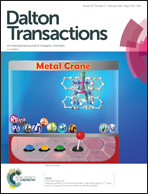Photoluminescence and energy transfer behavior of narrow band red light emitting Li3Ba2Tb3(MoO4)8:Eu3+†
Abstract
This work concerns the polycrystalline red emitting solid state compound Li3Ba2(Tb1−xEux)3(MoO4)8, from which a series of powder samples was prepared by a conventional solid-state reaction. The phase formation of the samples was investigated by X-ray diffraction which revealed the formation of a solid solution without a miscibility gap. Photoluminescence (PL) spectra and decay curves were recorded as a function of Tb3+ and Eu3+ concentration and temperature. It turned out that the external quantum efficiency of Eu3+ photoluminescence is between 30 and 80%, while the highest quantum yield is achieved for about 60% Tb3+. An increase of emission intensity can be realized by co-doping of Eu3+ and Tb3+. Moreover, the emission has a luminous efficacy of 275 lm Wopt−1 which is a distinct advantage over the widely applied Mn4+ activated fluorides. The time dependent photoluminescence as a function of Tb3+ concentration demonstrates the presence of an efficient energy transfer from Tb3+ to Eu3+. Temperature dependent PL measurements revealed that Li3Ba2(Tb1−xEux)3(MoO4)8 loses just 20% of PL efficiency up to 400 K. Therefore, the investigated phosphors are attractive for application in pcLEDs. It is finally demonstrated that the application of a Eu3+/Tb3+ co-doped ceramic disc is useful for the colour conversion of a blue emitting LED with a higher conversion rate compared to Li3Ba2(La1−xEux)3(MoO4)8.



 Please wait while we load your content...
Please wait while we load your content...